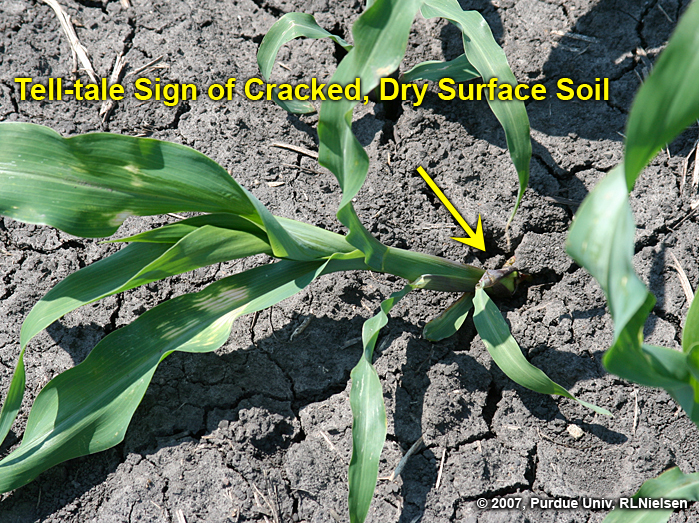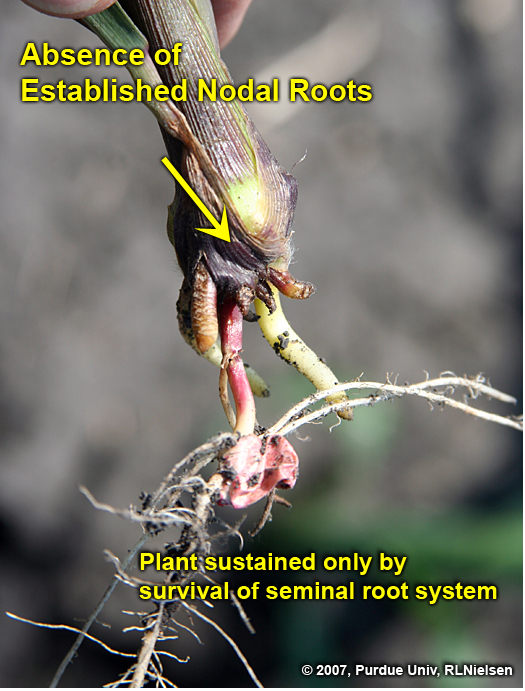
Pest & Crop
Newsletter
Purdue Cooperative Extension Service

Purdue Cooperative Extension Service
Issue 12, June 16, 2017 • USDA-NIFA Extension IPM Grant
As in the past, our first soybean aphid sighting of the year comes from the northern part of the state, specifically near the St. Joseph/Marshall county line. Thanks to Gary Battles for alerting us to this finding – a few handfuls of aphids on early V-stage beans. These populations typically peter out before getting near threshold levels, but should be monitored nevertheless.
Indiana is a “second-tier” aphid state in some ways: we typically don’t get the large early infestations that states such as Michigan and Minnesota do, probably because we have less of the overwintering host plant (buckthorn). Therefore, northern areas of the state that are closer to these high-pressure areas will usually report aphids first. Populations can build quickly, and treatable infestations (i.e. over 250 aphids/plant) in June are not unheard of, although they are relatively rare. Soybean aphids can be finicky about weather and conditions that include high heat and strong storms can prevent populations from building. Note that August is typically Indiana’s heaviest month for aphids, although it's been several years since populations have exceeded threshold levels in most of the state. We will continue to track aphids throughout the growing season.

Scouting V2 soybean for aphids.

Ant hill at base of infested plant.

Ant tending the aphids, note the parasitized aphids.
| County | Cooperator | Wk 1 | Wk 2 | Wk 3 | Wk 4 | Wk 5 | Wk 6 | Wk 7 | Wk 8 | Wk 9 | Wk 10 | Wk 11 | Wk 12 | Wk 13 |
|---|---|---|---|---|---|---|---|---|---|---|---|---|---|---|
| Dubois | SIPAC Ag Center | 0 | 0 | 0 | 101 | 193 | 16 | 0 | 3 | 31 | 6 | 8 | 5 | 4 |
| Jennings | SEPAC Ag Center | 0 | 1 | 1 | 56 | 57 | 9 | 4 | 32 | 4 | 4 | 13 | 4 | 4 |
| Knox | SWPAC Ag Center | 0 | 13 | 26 | 42 | 189 | 57 | 2 | 10 | 20 | 13 | 89 | 15 | 5 |
| LaPorte | Pinney Ag Center | 0 | 0 | 3 | 352 | 936 | 382 | 154 | 445 | 750 | 100 | 112 | 82 | 22 |
| Lawrence | Feldun Ag Center | 4 | 108 | 216 | 246 | 650 | 348 | 112 | 31 | 40 | 74 | 61 | 55 | 8 |
| Randolph | Davis Ag Center | 0 | 29 | 41 | 528 | 1232 | 300 | 72 | 10 | 298 | 44 | 21 | 87 | 17 |
| Tippecanoe | Meigs | 0 | 2 | 15 | 107 | 730 | 243 | 98 | 95 | 86 | 21 | 70 | 9 | 8 |
| Whitley | NEPAC Ag Center | 0 | 34 | 90 | 537 | 1689 | 1349 | 855 | 665 | 1265 | 334 | 127 | 416 | 48 |
Wk 1 = 3/16/17 - 3/22/17; Wk 2 = 3/23/17 - 3/29/17; Wk 3 = 3/30/17 - 4/5/17; Wk 4 = 4/7/18 - 4/12/17; Wk 5 = 4/13/17 - 4/19/17; Wk 6 = 4/ 20/17 - 4/26/17; Wk 7 = 4/27/17 - 5/3/17; Wk 8 = 5/4/17 - 5/10/17; Wk 9 = 5/11/17 - 5/17/17; Wk 10 = 5/18/17 - 5/24/17; Wk 11 = 5/25/17-5/31/17; Wk 12 = 6/1/17 - 6/7/17; Wk 13 = 6/8/17 - 6/14/17
Excessive drying of the upper soil profile is conducive for the development of what some of us affectionately call the "rootless corn" or "floppy corn" syndrome. The problem illustrates a classic example of the importance of the timing of stress versus stage of plant development.

Seminal roots, but no upper nodal roots.
The permanent (nodal) roots of a corn plant develop initially from near the crown area of the young plant (approximately 3/4 inch below the soil surface) and are often first visible between leaf collar stages V1 and V2 (Nielsen, 2013). The young roots develop sequentially in individual sets or "whorls" from individual nodes of the lower stalk, beginning with the lowermost node of the stalk. The main growing point or meristem of a root is located just behind the tip of the root and must remain alive in order for the root to develop normally.
Contrary to popular opinion down at the coffee shop, roots do not grow down toward moisture on purpose. They grow downward simply in response to gravity (i.e., a gravitropic response). If nodal roots begin their initial elongation in bone-dry surface soil and reach adequate soil moisture at deeper depths before the meristematic root tip desiccates, then the root will survive and proliferate.
If the root tip (and its accompanying meristem) desiccates prior to reaching soil moisture, the entire young nodal root often dies. This is particularly true if the axillary meristems along the length of the root (that eventually produce the adventitious branch roots) have not yet differentiated or become active.
The desiccating effect of bone-dry surface soils on young, newly elongating nodal roots is exacerbated by sunny weather and hot temperatures. Dry soil warms more quickly, and dramatically, than wet soil. On a warm, sunny day with air temperatures in the high 80s to low 90s F, soil temperature at the 3/4 inch or depth can exceed lethal levels. This is especially true for residue-free, conventionally-tilled fields.
The appearance of desiccated roots is what one would imagine; they are shriveled and discolored. This symptom is unlike that of any other lethal root stress, including salt injury from fertilizer. These symptoms are NOT like any associated with herbicide injury or insect feeding.

Desoccated amd dead nodal roots.
Entire sets or "whorls" of nodal roots sometimes die in this manner and the plant essentially survives on what's left in the kernel reserves and what the seminal roots offer in terms of moisture and nutrient uptake until the next set of nodal roots develop and become established. If subsequent sets of nodal roots die in the same manner, the plant continues its dependence on the kernel and seminal root support.
In fact, it is amazing to me how the aboveground appearance of a plant affected by the "rootless" syndrome can appear fairly normal up until the fateful windy day when the mesocotyl simply can no longer support the plant and it literally flops over to the ground. "Floppy" corn plants are NOT technically root-lodged; they are simply broken over at the mesocotyl below the crown area of the plant. Obviously, the health of the mesocotyl and the seminal roots determine whether an affected plant can "hang on" until a decent soaker occurs to replenish soil moisture levels.
I began this article by telling you that the "Floppy Corn" Syndrome is a classic example of the importance of the timing of stress versus stage of plant development. Rooting of young plants is most vulnerable to the effects of dry surface soils up until the nodal root system has been fairly well-established (about V5 or V6). Consequently, "Floppy Corn" is more likely to occur in a field of younger, recently-planted corn than an adjacent field of older, earlier-planted corn whose nodal root development is farther along.
Sometimes when several sets of nodal roots desiccate and die, the crown of the young plant may "appear" to be at or above the soil surface. That appearance is an optical illusion except in a few cases (Nielsen, 2004).
What Can Be Done to Alleviate the Problem? Unfortunately, very little can be done to prevent the situation from becoming worse. Row cultivation may encourage new nodal root development if moist soil is thrown around the base of the plants. However, if the soil is dry enough to be causing the problem in the first place, there's probably very little moist soil shallow enough to be brought up by row cultivation. The ultimate solution to the problem is a good soaking rain or at least enough of a rain to sustain new nodal root development long enough to allow the roots to reach deeper and hopefully wetter soil conditions before the upper soil dries again.

Early stage of "floppy" corn.

Early stage of "floppy" corn.

Absence of established nodal roots.

Broken mesocotyl.
Elmore, Roger and Lori Abendroth. 2007. Rootless Corn Syndrome. Integrated Crop Management Newsletter, Iowa State Univ. http://www.ipm.iastate.edu/ipm/icm/2007/5-21/rootless.html. [URL accessed June 2017].
Hoegemeyer, Tom. 2012. Why "Rootless" Corn is so Prevalent in Drier Areas this Year. CropWatch, Univ Nebraska Extension. http://cropwatch.unl.edu/why-rootless-corn-so-prevalent-drier-areas-year-unl-cropwatch-june-2012. [URL accessed June 2017].
Kelley, Jason. 2016. Rootless Corn Syndrome: A Real Problem. Arkansas Row Crops, Univ. Arkansas. http://www.arkansas-crops.com/2016/04/15/rootless-syndrome-problem. [URL accessed June 2017].
Lauer, Joe. 2001. Rootless or "Floppy" Corn. Wisconsin Crop Manager Newsletter, Univ. of Wisconsin. http://corn.agronomy.wisc.edu/WCM/W090.aspx. [URL accessed June 2017].
Nielsen, R.L. (Bob). 2004. Over-Extended Mesocotyls and Floppy Corn Syndrome. Corny News Network, Purdue Extension. http://www.kingcorn.org/news/articles.04/FloppyCorn-0624.html. [URL accessed June 2017].
Nielsen, R.L. (Bob). 2007. Variable Emergence Due to Variable Seedbed Moisture. Corny News Network, Purdue Extension. http://www.kingcorn.org/news/articles.07/VariableEmergence-0520.html. [URL accessed June 2017].
Nielsen, R.L. (Bob). 2013. Root Development in Young Corn. Corny News Network, Purdue Extension. http://www.kingcorn.org/news/timeless/Roots.html. [URL accessed June 2017].
Thomison, Peter. 2014. "Rootless" and "Floppy Corn" Make an Appearance. C.O.R.N., Ohio State Extension. https://goo.gl/i2OOvj. [URL accessed June 2017].
Wiebold, William. 2012. Rootless Corn. Integrated Pest & Crop Management, Univ. Missouri Extension. https://ipm.missouri.edu/ipcm/2012/5/Rootless-Corn. [URL accessed June 2017].
Purdue Extension Entomology
901 W. State Street
West Lafayette, IN, 47907
(765) 494-8761
luck@purdue.edu
@PurdueExtEnt
PurdueEntomology
If you would like to be alerted by e-mail when the current issue of the Pest&Crop is available on-line, please enter your e-mail address and click the submit button.
It is the policy of the Purdue University Cooperative Extension Service that all persons have equal opportunity and access to its educational programs, services, activities, and facilities without regard to race, religion, color, sex, age, national origin or ancestry, marital status, parental status, sexual orientation, disability or status as a veteran. Purdue University is an Affirmative Action institution. This material may be available in alternative formats.